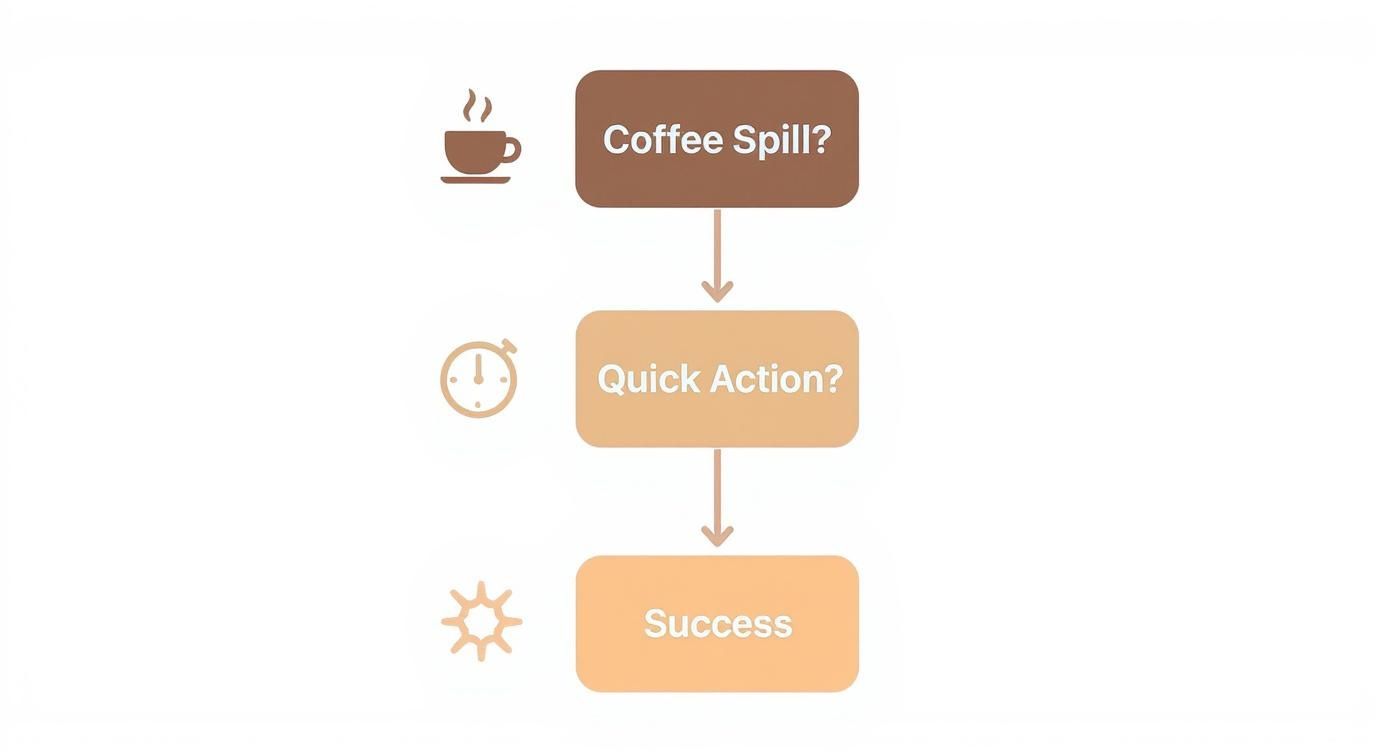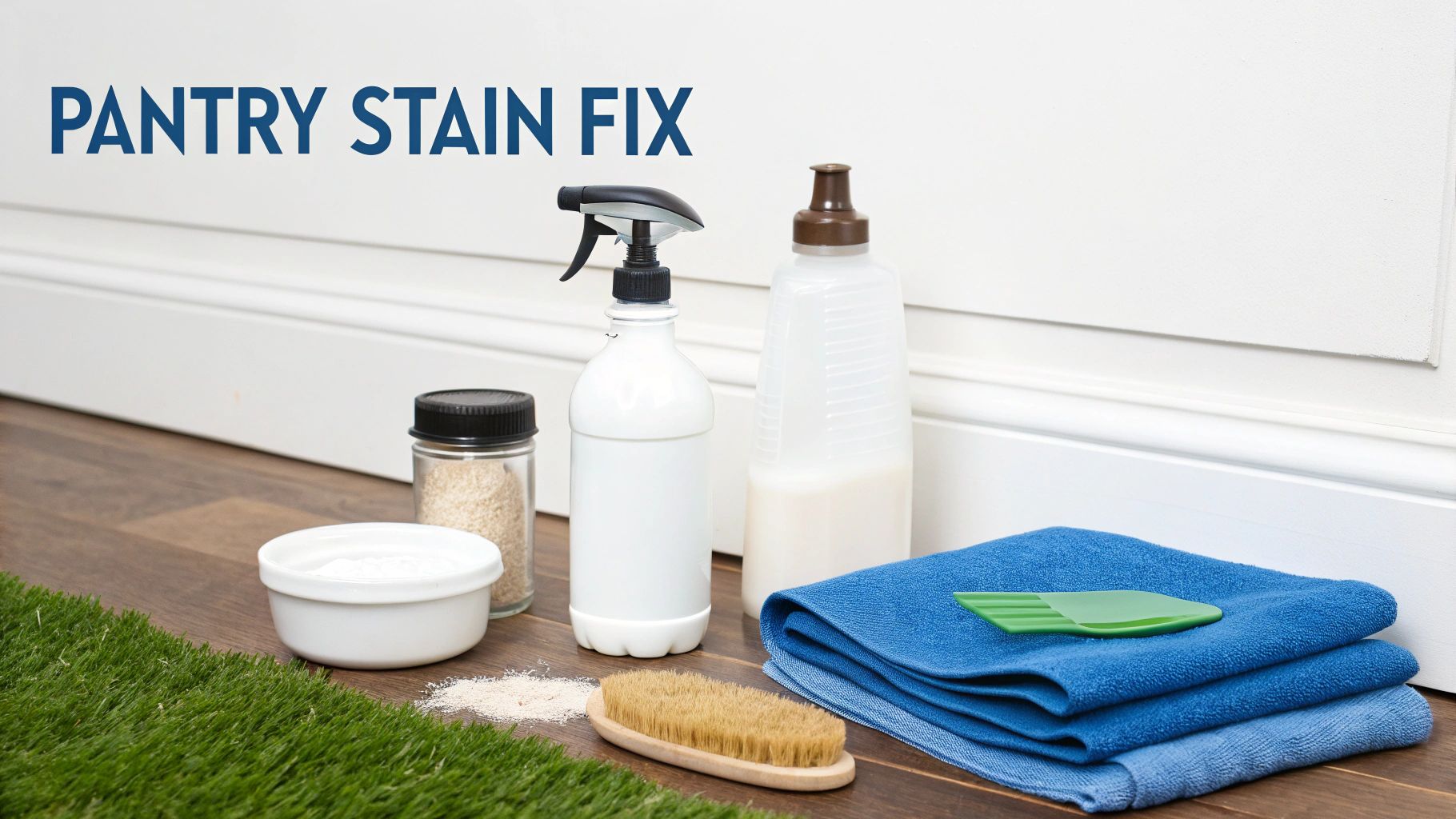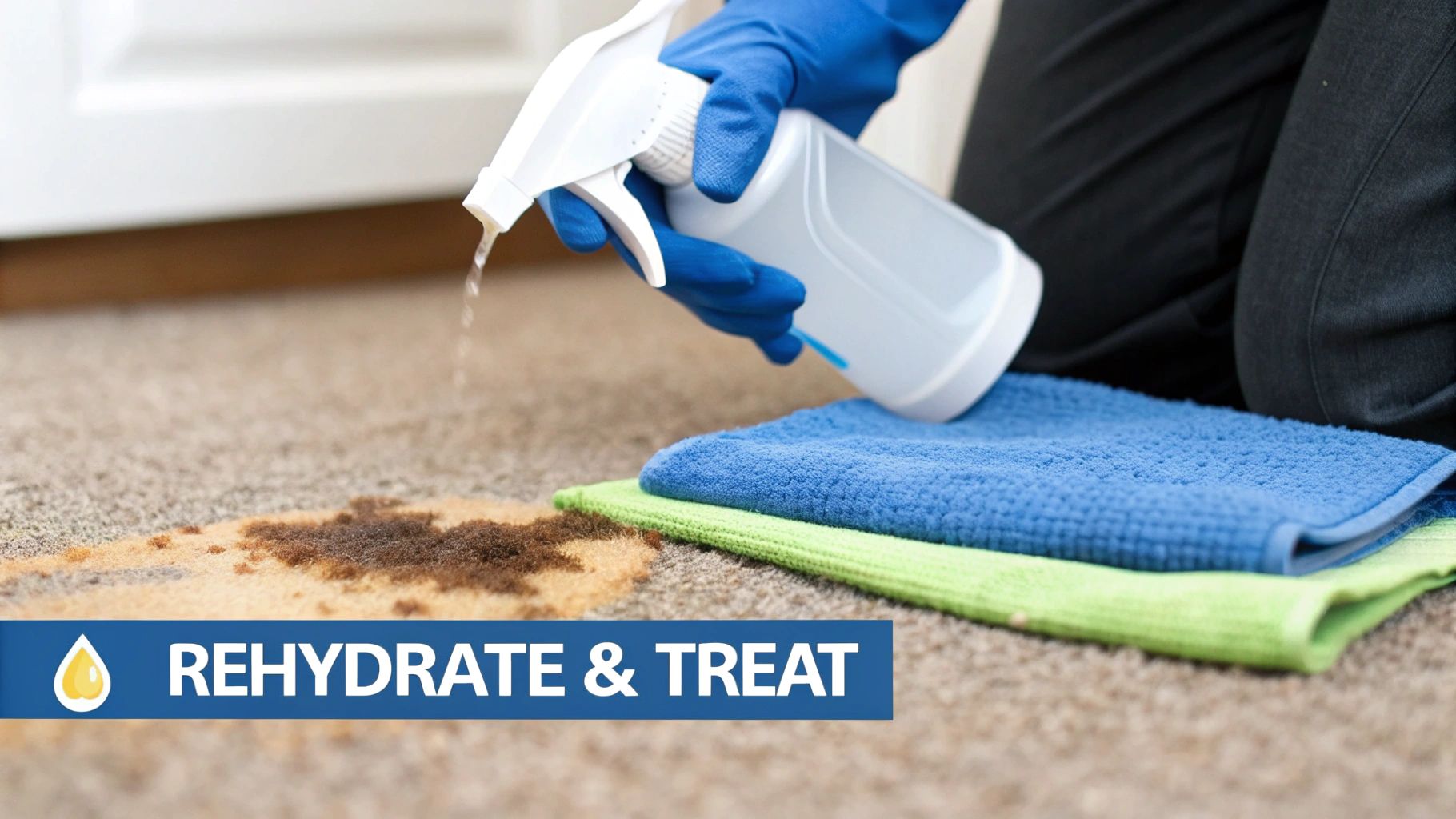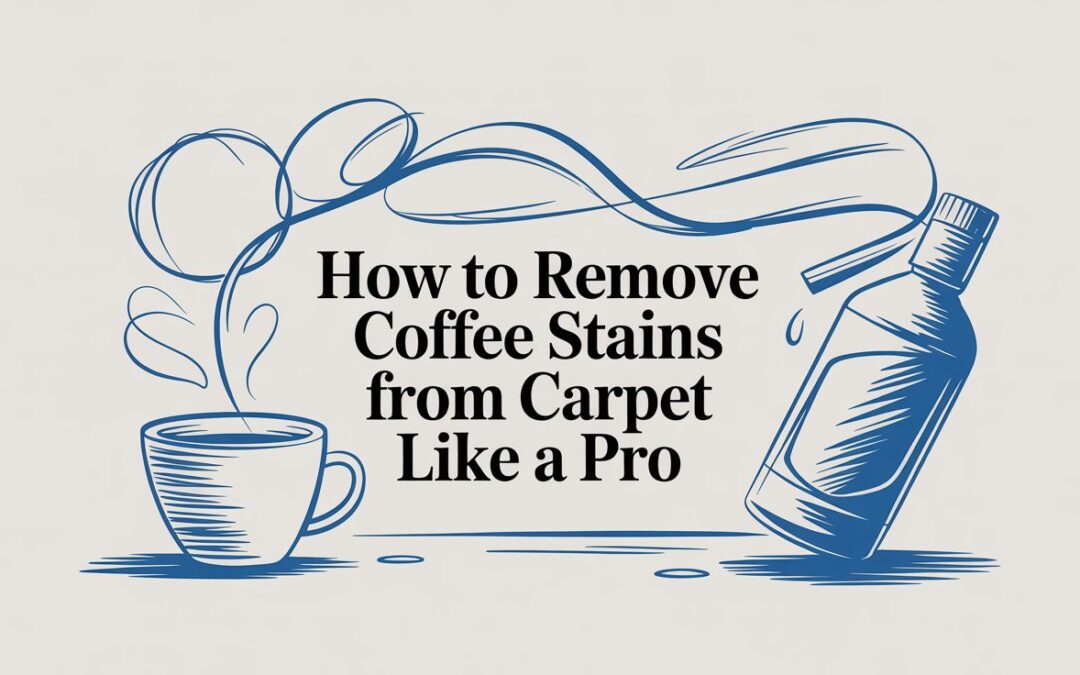It’s a feeling every coffee lover knows and dreads: that split-second slip, and suddenly your morning brew is a dark, spreading puddle on the carpet. It’s easy to panic, but what you do in the next few minutes is critical.
The fastest way to tackle a fresh coffee spill is to blot it immediately with a clean, dry cloth. Don’t rub! Just press down firmly to soak up as much liquid as you can. Next, dampen a fresh cloth with cold water, and continue blotting the area until you can’t see any more colour transferring to the cloth. This simple, swift action is your best defence against a permanent mark.
Why Coffee Stains Are So Stubborn
That moment of panic when coffee hits the floor is completely justified. A coffee stain isn’t just a surface mess; it’s a chemical reaction happening deep inside your carpet’s fibres, and understanding the ‘why’ helps you fight it more effectively.
Coffee is packed with natural compounds called tannins—the very same things that give tea and red wine their rich colour. Tannins act like a dye, bonding aggressively to carpet fibres, particularly the synthetic types like nylon or polyester that are common in many Australian homes. This is why a simple spill can create such a deep, challenging brown stain.
The Critical First Few Minutes
Think of the first moments after a spill as the “golden hour” for stain removal. The longer coffee sits, the more time those tannins have to soak in and set, making the mark much harder to lift later. Acting correctly and immediately can be the difference between a minor cleanup and a permanent eyesore.
This guide is here to get you past the initial shock, giving you practical, real-world steps to confidently tackle any coffee stain that comes your way.
It’s no surprise that coffee stains are one of the most common household spills we see. Australia has a vibrant coffee culture, with cities like Melbourne celebrated globally for their cafés. Naturally, higher consumption leads to more accidents at home, making quick and effective removal skills essential. You can learn more about how common coffee stains are on Australian carpets.
Don’t worry, a clean, stain-free carpet is absolutely achievable. Knowing how to act fast and which tools to grab—whether from your pantry or the local shops—gives you the power to protect your flooring and keep your home looking its best.
Your First Response to a Fresh Coffee Spill
That heart-stopping moment when a mug of coffee goes tumbling onto the carpet—we’ve all been there. Your first few seconds of reaction can mean the difference between a simple clean-up and a permanent, ugly brown stain. The biggest mistake people make is panicking and scrubbing furiously. Resist that urge! Your immediate goal is much simpler: absorb as much of that spilled coffee as you possibly can, as gently as possible.
Grab a clean, dry, white cloth or a thick stack of paper towels. It’s important to use a white cloth so you don’t accidentally transfer any dye onto your carpet. Plus, it helps you see just how much coffee you’re successfully lifting out. Press the cloth firmly down onto the spill. Blot, blot, and blot some more. Whatever you do, don’t rub. Scrubbing just grinds the coffee deeper into the carpet fibres and spreads the stain, turning a small problem into a much bigger one.
The Art of Blotting Correctly
Think of it as carefully lifting the liquid out, not attacking the carpet. As soon as your first cloth is soaked, get a fresh, dry one and keep going. Here’s a pro tip we’ve learned over the years: always work from the outside edge of the spill and move inwards. This simple trick contains the stain and stops it from spreading while you work. You’ll see the coffee moving from the carpet to your cloth, which is exactly what you want. Keep this up until the cloth is coming away almost dry.
This quick decision tree shows how acting fast is the most reliable path to getting a coffee stain out completely.

As the visual shows, immediate blotting and dilution are the two non-negotiable first steps if you want to prevent a permanent mark.
Once you’ve blotted up all the excess liquid, it’s time to dilute what’s left. Lightly dampen a new, clean cloth with cold water. Hot water is your enemy here; it can cause the tannins in coffee to bond with the carpet fibres permanently. Gently dab the damp cloth onto the stain, again working from the outside in. This helps to water down the coffee that has already started to soak in.
Next, switch back to a dry cloth and blot the area again to soak up the diluted coffee and water mixture. You’ll likely need to repeat this cycle of dampening and blotting a few times. With each round, you should see the stain getting lighter and lighter. This initial response is like critical first aid for your carpet.
The importance of speed cannot be overstated. Industry statistics show that treating a spill promptly results in a 90% success rate for complete stain removal. However, waiting more than 24 hours drops that success rate to below 50%. This is why consumer campaigns in Australia often stress acting within the first 10 minutes. You can find more real-world advice on why quick action is key for effective stain management on forums like MoneySavingExpert.
By performing this immediate blotting and diluting process, you’ve dramatically improved your chances of removing the stain completely. You’ve also perfectly prepped the area for the deeper cleaning methods we’ll cover next.
DIY Stain Removers from Your Pantry
Before you rush out to buy a specialised cleaning product, pop your head into the kitchen pantry first. You’d be surprised at what you find. You likely already have a few powerful, budget-friendly ingredients that can work wonders on a fresh coffee stain, saving you both time and money.
When used correctly, simple household items are often just as effective as their commercial counterparts.

The key is to match the right solution to the type of coffee spill you’re dealing with. A simple black coffee stain needs a different approach than a milky latte loaded with sugar.
The White Vinegar and Water Solution for Black Coffee
For a standard black coffee spill, your best friend is good old white vinegar. Its natural acidity is fantastic at breaking down the tannins in coffee—that’s the stuff that causes the dark brown stain. It’s a simple but remarkably effective method that professionals have relied on for years.
Here’s how to whip up the solution:
- Mix one part white vinegar with one part cold water.
- Pour the mixture into a clean spray bottle. This makes it much easier to apply without soaking everything.
- Lightly spritz the stained area, but be careful not to oversaturate the carpet. You want it damp, not drenched.
Let the solution sit for about five to ten minutes to work its magic. Then, grab a clean, white cloth and gently blot the area to lift the stain. Just keep repeating this process until the stain is gone.
Tackling Milky or Sugary Coffee Spills
Did your spill involve a flat white or a sweet cappuccino? The moment milk, cream, or sugar enters the picture, you’re dealing with fats and proteins. That means you need a solution that can cut through grease, and a gentle dish soap mixture is perfect for this.
Mix one tablespoon of clear, mild dishwashing liquid with two cups of cool water. Just like with the vinegar solution, apply it sparingly to the stain and blot gently with a clean cloth. The soap will help dissolve that sugary, oily residue that milk leaves behind.
Crucial Tip: Always—and I mean always—do a patch test before putting any homemade solution on your carpet. Find an inconspicuous spot, like inside a closet or under a sofa, and apply a tiny amount of your cleaning mixture. Wait for it to dry completely to make sure it doesn’t cause any discolouration or damage to the carpet fibres.
Using a Baking Soda Paste for Tougher Spots
Sometimes, even after your best efforts, a faint mark might hang around. This is where baking soda (or bicarbonate of soda) comes to the rescue. It acts as a gentle abrasive and a natural absorbent, helping to pull the last remnants of the stain from deep within the carpet fibres.
Creating a baking soda paste couldn’t be easier:
- In a small bowl, mix three parts baking soda with one part water.
- Stir until it forms a thick, spreadable paste, roughly the consistency of toothpaste.
- Gently apply the paste directly onto the damp stain, making sure to cover it completely.
As the paste dries, it will literally draw the stain upwards and out of the carpet. Let it dry completely—this might take a few hours—and then vacuum the area thoroughly to suck up all the dried residue. This final step often lifts that last stubborn bit of discolouration and helps to neutralise any lingering coffee odours.
Choosing the Right Commercial Stain Remover
Sometimes, your trusty pantry solutions just won’t cut it. When a coffee stain is particularly stubborn, stepping up to a commercial product gives you the extra muscle needed to get the job done right. But walking down the cleaning aisle can feel overwhelming, with dozens of bottles all promising miraculous results.
The secret is knowing what’s actually in the bottle and matching it to what was in your mug.
Black Coffee vs. Milky Coffee: Pick the Right Formula
Not all coffee stains are created equal, and the type of cleaner you need depends entirely on how you take your coffee.
For a straight-up black coffee spill, your best bet is an oxygen-based cleaner. These products work by releasing active oxygen that breaks down the tannins in coffee. Think of it as a gentle bleaching action that lifts the stain without stripping the colour from most carpets.
But if you’ve spilled a latte, flat white, or anything with milk or creamer, you need a completely different approach. Those milky drinks contain proteins and fats that oxygen cleaners won’t touch. For these messes, you need an enzymatic cleaner. The enzymes in these formulas are specifically designed to digest organic stuff like proteins and fats, literally eating away at the stain.
How to Read the Label Like a Pro
Grabbing the right formula is half the battle; you also have to make sure it’s safe for your specific carpet. Before you even think about putting a product in your trolley, flip it over and check the label.
- Carpet Fibre Type: Look for cleaners that are explicitly marked as safe for your carpet’s material. Wool, for instance, is a natural fibre and can be easily damaged by harsh chemicals, so you’ll absolutely need a wool-safe formula. Most synthetic carpets like nylon or polyester are much more forgiving.
- Application Instructions: Pay close attention here. The label will tell you exactly how long the product needs to sit (the “dwell time”) and how to apply it. Some are designed for a quick spray-and-blot, while others need to work their magic for a few minutes.
- Safety Warnings: Always check for warnings about ventilation or skin contact. It’s always a good idea to crack a window open when you’re working with these products.
A huge mistake we see all the time is people drowning the stain in cleaner. It feels like more product should mean a deeper clean, but it often does the exact opposite. Too much liquid soaks right through to the carpet backing and underlay, creating a damp, dark environment that’s perfect for mould and mildew. You’ve solved one problem only to create a much bigger, smellier one.
The goal is to use just enough product to treat the stained fibres without soaking the layers underneath. Apply it sparingly, blot it thoroughly, and make sure the area is completely dry when you’re done. This careful approach lets you get the powerful benefits of a commercial cleaner without accidentally causing permanent damage.
How to Tackle Old Set-In Coffee Stains
Finding an old coffee stain that’s had hours—or even days—to set into your carpet can feel like a lost cause. Fresh spills are one thing, but a dried, oxidised stain is a different beast entirely. Don’t throw in the towel just yet. With a bit of patience and the right strategy, you can still get even the most stubborn coffee stains out of your carpet.

Unlike a fresh spill where your first instinct is to absorb liquid, your job with an old stain is to bring it back to life. A dried stain is essentially dormant, and no cleaning solution will do much good until you rehydrate it.
First Things First: Rehydrate the Stain
Start by dampening a clean, white cloth with warm water. Be careful not to use hot water, as high heat can still set the tannins in the coffee, making the stain permanent.
Gently press the damp cloth onto the old stain and hold it there for a minute or two. The goal here is just to moisten the dried coffee, making it receptive to treatment without soaking the carpet’s backing and underlay.
Once the area feels slightly damp, you’re ready to move on to a more potent cleaning solution. The DIY methods we mentioned earlier can still work, but set-in stains often need a bit more power.
A Stronger Solution for Light-Coloured Carpets
For light-coloured synthetic carpets, a carefully prepared hydrogen peroxide solution can be incredibly effective. Peroxide has a mild bleaching effect that’s fantastic for breaking down the dark tannin compounds in old coffee stains.
A Critical Warning: Hydrogen peroxide can permanently discolour wool, silk, or dark-coloured carpets. It is absolutely essential to test this solution on a hidden spot first. Apply a small amount in a wardrobe or under a sofa, wait until it is completely dry, and check to ensure it hasn’t altered your carpet’s colour.
To mix up the solution:
- Combine one part 3% hydrogen peroxide with three parts cold water.
- Add a single drop of clear, gentle dish soap to help break down any oils.
- Pour the mixture into a spray bottle for controlled, even application.
The Layering and Blotting Technique
With your chosen solution ready, it’s time to tackle the stain using a layering method. Lightly spray the rehydrated stain, making sure you cover the entire spot but don’t saturate it. Over-wetting the carpet is a common mistake that can lead to bigger problems.
Now, let the solution dwell on the stain for 5 to 10 minutes. This waiting period is crucial. It gives the cleaner time to penetrate deep into the carpet fibres and chemically break down the set-in coffee molecules. Rushing this step is why many DIY attempts fail.
After the dwell time, take a fresh, dry, white cloth and blot the area firmly. You should start to see the brown stain transferring from the carpet to your cloth. If the stain is still visible, simply repeat the process: lightly spray, let it dwell, and blot again. A really stubborn mark might take two or three cycles to lift completely.
Don’t Skip the Final Rinse
Once the stain has vanished, you’re almost done—but don’t skip the final, essential step: a thorough rinse. Any leftover cleaning residue, whether it’s from vinegar, soap, or peroxide, will become sticky as it dries. This sticky patch acts like a magnet for dirt and dust, and before you know it, you’ll have a new, dark spot right where the old one was.
To rinse properly, lightly dampen a clean cloth with cold water and blot the area repeatedly. This dilutes and lifts any remaining cleaning solution from the fibres.
Finally, blot the area with a dry cloth or a thick stack of paper towels to absorb as much moisture as possible, then let it air dry completely.
When to Call in a Professional Cleaner
While DIY methods are fantastic for catching most coffee spills, there’s a point where you can do more harm than good. Knowing when to step back and call in the experts is just as important as knowing how to blot a fresh stain. It’s all about protecting your investment in your carpet.
you
Sometimes, the risk of permanently setting a stain or damaging delicate fibres just isn’t worth the satisfaction of a DIY win. Recognising the signs that you’re out of your depth can save you from a costly mistake. If any of the following situations sound familiar, it’s a strong signal that it’s time to pick up the phone.
Identifying Professional-Only Scenarios
Look, calling an expert isn’t admitting defeat. It’s making a smart, calculated decision to get the best possible outcome for your carpet. Certain spills and carpet types simply demand a level of care that household products can’t deliver.
You should seriously consider calling a professional cleaner if:
- The Spill is on Delicate Fibres: If your carpet is made of natural materials like wool or silk, you have to be incredibly careful. Harsh DIY chemicals or even just scrubbing too hard can cause irreversible damage like colour bleeding or fraying. Professionals know the specific pH levels and cleaning agents that are safe for these materials.
- You’ve Tried Multiple Methods Without Success: If you’ve already had a go with a couple of different cleaning solutions and the stain is still staring back at you, stop. Layering different chemicals can create a nasty reaction that permanently sets the coffee stain, making it impossible for even a pro to get out.
- The Coffee Stain is Very Large or Old: A massive spill that has soaked deep into the carpet padding or an old, oxidised stain is usually beyond the scope of simple blotting and spraying. These situations require the power of professional equipment to pull the stain out from the base of the fibres.
Your goal is to remove the stain, not create a bigger problem. If you’re feeling unsure or the stain isn’t budging after your first careful attempt, it’s often more cost-effective in the long run to consult an expert like Right Price Carpet Cleaning.
The Power of Professional Equipment
Let’s be honest—the gear a professional carpet cleaner brings to your home is in a different league than anything you can rent or buy at the shops. The biggest advantage they have is hot water extraction, which you might know as steam cleaning. These are powerful, often truck-mounted machines that blast a high-pressure solution of hot water and cleaning agents deep into the carpet pile.
This process does two things at once: it breaks down stubborn, embedded stains and then immediately sucks out all the dirt, coffee residue, and leftover cleaning solution with incredibly powerful suction.
The result is a much deeper clean and significantly faster drying times, which is crucial for preventing mould and mildew from taking hold. For a stubborn coffee stain, this combination of heat, pressure, and powerful extraction is the ultimate weapon.
Got Questions About Getting Coffee Stains Out?
When you’re faced with a coffee spill, a few questions always seem to pop up. Knowing the right answers can be the difference between a successful cleanup and a permanent reminder of your morning caffeine fumble.
“Should I Use Hot Water on the Stain?”
This is probably the most common question I hear, and the answer is a firm no. You should always use cold water on coffee stains. Why? Hot water actually has a chemical reaction with the tannins in coffee, effectively “cooking” the stain right into your carpet fibres. Once that happens, it’s incredibly difficult—sometimes impossible—to get out.
“What If My Coffee Had Milk or Sugar in It?”
A great question. Spills aren’t always just straight black coffee. If your latte or sugary brew hits the floor, you’ll need a little extra help. For these types of spills, simply add a few drops of dish soap to your cold water cleaning solution. The soap is designed to break down fats and sugars, tackling the sticky residue that plain water or vinegar might leave behind.
Article created using Outrank





Recent Comments